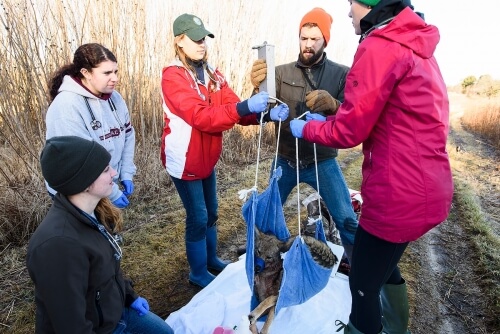Urban Canid Project: What we can learn when we stop and look around
A recent video of two foxes ambling around Bascom Hill, seemingly unbothered by the human presence, shot by Argyle Wade, chief of staff for the Vice Chancellor for Student Affairs.
COVID-19 forced us to change our behavior; our world shut down in ways many of us never imagined. But what about animals?
How, if it all, did the pandemic change wildlife behavior? Did animal behavior change in response to alterations in human behavior and patterns?
When the pandemic started in March 2020, people started noticing a lot of wild animals that David Drake, director of Urban Canid Project, studies. Urban Canid Project, founded in 2014, tracks foxes, coyotes, and other canids in the Madison area. The project works to educate the public about canids, as well as suggest ways for humans and wildlife to coexist.
Drake noted that there’s currently a “meta-analysis” examining the possible correlation between animal patterns and a change in human behavior since the pandemic started, and if animals started acting differently because of a change in human behavior.
“The data suggests that there hasn’t been any change in wildlife patterns [and] behavior,” Drake shared.
He hypothesized that the reason that some believe more animals are being seen is for the simple fact that people were able to observe them more.
“I think [what] happened during the pandemic, is [that] we were forced to observe… so we had the opportunity to look out our windows or sit outside,” Drake said, “I think the result of that is [that] people were seeing things that were always around them [but] they didn’t have the opportunity to observe them [before the pandemic],” Drake shared.
Drake noted that a wildlife presence on the UW campus pre-dates the pandemic, even if people didn’t always observe them.
“We’ve had coyotes and foxes on campus for years… we’ve had deer or fox or snowy owls in the wintertime,” he shared, “a lot of those species are adaptable and they’re comfortable being around people.”
A recent video of two foxes ambling around Bascom Hill, seemingly unbothered by the human presence, was shot by Argyle Wade, chief of staff for the Vice Chancellor for Student Affairs.
The Urban Canid Project soon hopes to restart its tradition of inviting the public to join when they trap animals to tag and radio collar them for study, Drake said. That practice was discontinued during the pandemic.
“We just take [the public] with us on our trap checks and we explain to them how we trap, why we trap, what we’re doing with the data, [and] the purpose of the project,” Drake said.
Members of the public are invited to be as involved in the trapping process as they want to be and to take pictures with the animals and touch them.

Students weigh a coyote trapped as part of the Urban Canid Project in 2019. Photo: Jeff Miller
“It’s an opportunity for people to personalize with that animal and not look at it so much as a villain but actually see this animal as this really cool species of wildlife,” Drake said, “they have a totally different perspective on those animals.”
This past winter was the worst trapping season the project has seen since they began in 2014, Drake said, possibly because of increased human presence outdoors.
“I think we had such poor results because there were a lot of people walking [outside],” Drake said, “so there were a lot more people out in the areas… and I think that upset the animals’ moving patterns because of so much human presence and activity.”
Currently, Drake is working on a project to study food availability for animals, and how this may impact coexistence between different species. That includes food availability both from a natural standpoint, which includes other animals and plants, as well as an anthropogenic standpoint, like people’s trash cans.
UW graduate student Morgan Farmer is working closely with Drake through this project. He noted that this research will allow researchers to better understand how animals like foxes and coyotes peacefully coexist, and the connection to food abundance and access for animals.
“The animals don’t have to compete for limited amounts of food,” Drake said, “we think that’s going to help us understand what’s driving this coexistence.”
While the Urban Canid Project waits to return, Drake said one thing that he’s been really grateful for since the start of the project: the amount of support the project has both from the UW–Madison and the broader Madison area.
“[UW-Madison] has been unbelievably supportive,” Drake said, “general members of the public… everyone is just extremely supportive of our project.”
